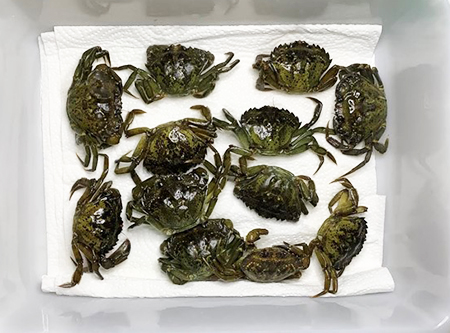
European green crabs haven’t made it to Sitka – not yet, anyway. During the Alaska Invasive Species Partnership workshop last Thursday (11-9-23) in Sitka, experts from around coastal Alaska spoke about current strategies to fight these invasive crabs, and how communities like Sitka can work to avoid being a pit stop for these crafty crustaceans.
“It’s simple: five spines on either side of the eyes, three bumps in between the eyes…”
Tammy Davis is the Invasive Species Program Coordinator for the Alaska Department of Fish & Game. She’s teaching a roomful of people in Sitka how to identify invasive green crabs – which, surprisingly, are not always green.
“They can be brown, they can be orangish, reddish, yellowish,” Davis continues. “They’re four inches — an adult is four inches across the back of the carapace.”
European green crabs first reached the Pacific coast in 1989, but it wasn’t until 2022 that they showed up in Alaska. Davis remembers the moment she learned that green crabs had been found in Metlakatla last summer.
“And I think we were all really close to tears, because we should have known they were coming,” Davis says. “But we didn’t think they would come this soon, I guess.”
Genelle Winter is the Climate & Energy Grant Coordinator for Metlakatla Indian Community. While Metlakatla is the only place in Alaska where green crabs have been positively identified, Winter says it’s likely that they’ve already spread.
“The numbers that we’re finding them in — we’re pretty sure that there are other places, we just haven’t found them yet,” Winter says. “And with that, right now, we’re just under 3000 crabs total that have been caught since discovering them in 2022.”
She says that aggressive trapping in Metlakatla, combined with early detection, has made it easier to reduce their spread.
“The first thing that was found was the first shell,” Winter says. “And that triggered that response to really start intensifying our trapping and then modifying how and where to make sure that we were really actually putting the traps where the crab were. And now those guys, they have it dialed in something fierce.”
These crabs tend to decimate eelgrass beds, which are critical habitat for juvenile salmon and other critters. They are also voracious eaters of clams and other small crabs. They reproduce quickly, and can survive in a wide range of environments.
Davis says communities like Sitka should be on the lookout.
“It seems so frightening and negative to say it’s inevitable, but based on ocean currents, it’s likely,” Davis says. “We don’t actually have good oceanographic information about currents in the Alexander Archipelago, so some of our Southeast communities may be slightly more protected if currents tend to go out along the coast. Unfortunately, that puts Sitka more likely.”
Davis says that Alaskans can help by learning how to identify green crabs and looking out for them on beach walks. While collecting some invasive species requires a permit, Alaska beachcombers can collect potential green crabs for the purposes of reporting – but they should keep the crab in a container and report the find immediately. You can report invasive species online through the Alaska Department of Fish & Game website or by calling the invasive species hotline at 1-877-INVASIV.






























